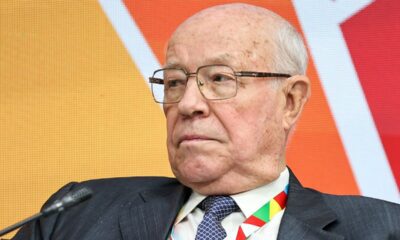Life And People
ALAAFIN – Out Of Many, One! -By Muftau Gbadegesin
As each of these prominent Kings continued to embark on the journey of no return, rumors, sentiments, and hearsay started to fill the air. Many painted the Governor as the mastermind behind the sudden death of Oyo’s most respected monarchs. But when the speculations and assumptions got to a stage, Governor Makinde had to clear his name by denying any foul play or wrongdoing in the death of iconic monarchs in the state. A brief walk into the past.

Symbolic, historic, and majestic, the throne of the Alaafin of Oyo in Yorubaland is unrivaled; its occupants, are powerful, strong, and influential.
In a way, the heroic exploits of successive Alaafins from time immemorial have etched their names in the pantheons of African legendary monarchs. Oranmiyan, the first King of Oyo certainly built an empire whose vast, rich, and enduring tentacles would spread far and beyond the shore of Nigeria.
He would create a kingdom whose enchanting symbolism, enthralling historicism, and the majesty of its King would forever be tied to the identity of its people: you cannot understand Oyo unless you have a grasp of its King and to sneak peek into the power and might of the Alaafin, you may have to understudy Oyo people. Intricately, the destiny of the King, the city and the people in other words are intertwined and inseparable. It is why the city has no separate eulogy except the one that extols the virtues and valor of the King. Oyo Alaafin is both a reference to the King and homage to the townsfolk. The throne of the Alaafin of Oyo is pace setting, its people pace setters.
So, whenever the stool of Oyo becomes vacant as it is now, don’t expect less from princes who jostled to be the next ‘Iku Babayeye Alase Ekeji Oosa’. For eons, the throne has always been the prize and contenders don’t always care about the price. Last weekend, a cultural firestorm erupted around remarks Governor Seyi Makinde made during the commissioning of LAUTECH, Iseyin campus. “Those of you fighting over Alaafin of Oyo’s stool should stop”, the Governor declared at the function. “Those who have collected money from people should know that Alaafin’s stool is not for sale. The stool is very important to Yoruba land, and we will not allow it sold to the highest bidder”. To take Makinde’s cultural firestorm a bit further, it helps to dissect the content of his remark: people fighting over Alaafin’s stool should stop. Is the stool of Alaafin no longer worth fighting for?
In fact, in some quarters, it is a stool worth dying for. It is the Alaafin stool we are talking about here. Not some elevated Obas whose sovereignty and relevance are tied to the apron strings of the constituted authority. For one, Makinde’s instructive homily both soothes and raises the specter of suspicions. Soothing because no one should use the power of money to get such an exalted position: we must be wary of wheeler dealers. But we deceive ourselves if we think money will not pay a role in the whole arrangement. Conversely, Makinde’s verbal explosive raises the dust of doubt because the selection process of Alaafin according to the head of Oyo Mesi, the Bashorun of Oyo has been concluded and the name of the Oba elect has been forwarded to the government since last year October for approval and announcement.
In an exclusive interview with the Punch Newspaper, High Chief Yusuf Akinade, the Bashorun of Oyo posited that “the traditional kingmakers in Oyo town have selected a new Alaafin and that they are only waiting for Oyo state Governor, Seyi Makinde, for a formal announcement”. The name of the selected Alaafin elect according to an unconfirmed document is Prince Lukman Gbadegesin.
In the history of Oyo state, no Governor has had to contend with the sudden demise of prominent and influential kings in one fell swoop! And no Governor has equally had the honor of installing all the prominent monarchs in the state than Governor Seyi Makinde.
In a matter of months between 2021 and 2022, most of the prominent kings in the state have joined their forebears in what has been described as rather breathtakingly unusual. What started quietly in the ancient Ogbomoso would snake into the city of Ibadan before returning to Oyo where death snatched the Lion of Akesan hill after many decades at the helms. The towns of Iseyin, Igbeti, and Igangan were also not spared as death continued to violently uproot kings from their stools. After 48 years on the throne, Soun Jimoh Oyewumi Ajagungbade became the first prominent king in the long list of traditional rulers to return home under Governor Seyi Makinde’s watch. He was 95 when he died. At 93, Olubadan Saliu Adetunji, the 41st Olubadan of Ibadan joined his forefathers on the 2nd of January, 2022. He reigned for six years. Four months later, Alaafin Lamidi Olayiwola Adeyemi breathed his last on the 22nd of April, 2022 at the age of 83. He spent 52 years on the throne. In 1970, he became the eighth Alaafin in the present-day Oyo after Atiba Atobatele, Adelu Agunloye, Alowolodu Adeyemi 1, Lawani Amubieya Agogo-Ija, Siyanbola Onikepe Ladigbolu 1, Raji Adeniran Adeyemi 11, and Bello Gbadegesin Ladigbolu 11.
As each of these prominent Kings continued to embark on the journey of no return, rumors, sentiments, and hearsay started to fill the air. Many painted the Governor as the mastermind behind the sudden death of Oyo’s most respected monarchs. But when the speculations and assumptions got to a stage, Governor Makinde had to clear his name by denying any foul play or wrongdoing in the death of iconic monarchs in the state. A brief walk into the past.
Robert Smith, author of Alaafin in Exile: A Study of the Igboho Period in Oyo History noted that “the Oyo of the Alafin are three: first Oyo-ile (‘home Oyo’), Oyo-oro (‘Oyo of the ghosts’), that ‘slippery place’ where Oranyan’s horse stumbled and slid, the Katunga of the Hausa; then Igboho, capital of four Alaafin who sought refuge there from the aggressions of their Nupe and Borgu neighbors; and lastly New Oyo, Ago d’Oyo (‘Ago become Oyo’), where since 1837 or thereabouts, after the destruction of Oyo-Ile by the Ilorin, the Alafin have continued to reign.
In essence, what is known today as Oyo and the throne of Alaafin have been an exercise in a series of dramatic and drastic transformations and transmogrifications. Neither Oyo nor the throne of its King has remained the same in its evolution and expansion. Internal insurrections and external aggressions have shaped both the throne and the city into one of the most enduringly formidable cultural heritages. Unlike what was obtained in some other traditional climes, the throne of the Alaafin has endured brickbats of unspeakable proportion. Instead of shrinking in reverence and respect, its power and influence continued to grow in leaps and bounds to the chagrin of its traducers.
Additionally, kings elsewhere and everywhere are representative of the gods on earth and their power authority and sovereignty are divine. “Say: “O Allah! Lord of Power (And Rule), thou givest power to whom Thou Pleasest, and Thou Strippest off power from whom Thou please: Thou enduest low whom Thou pleases: In Thy hand is all good. Verily, over all things Thou has power.” (Quran 3:26).
But somehow, no other institutions in the country have had to sustain a series of pernicious attacks on their existence than the traditional institutions. Politicians from across the North, West, East and South have continued to clip the wings of Kings and Monarchs through stuff and draconian laws. Unfortunately, the more politicians try to diminish the influence of kings, the more people see through their petty insecurity. In Oyo, the amendment of the chieftaincy law under Governor Makinde is in addition to various slaps in the wrist of the legacies of traditional institutions. Do you remember how former Kano state Governor, Abdullah Ganduje also yanked Muhammad Sanusi from the throne of his forebears in 2020? It is the way it is.
Quite instructively, we don’t need Governor Makinde to tell us the significance of the throne of Alaafin of Oyo. Walter Rodney, the famed author of How Europe Underdeveloped Africa chronicled the power and influence of the Alaafin in his book. “Among the most powerful rulers in West Africa was the Alaafin of Oyo, whose authority extended over a large territory” Rodney posited, “The Alaafin had a complex system of government with various officials and councils. He played an important role in the trans-saharan trade and maintained political stability through diplomacy and military power”.
Still, the question remains of why Governor Seyi Makinde hasn’t approved the selection of the Oyo Kingmakers after almost a year. Perhaps the Governor might have reservations in the arrangement that threw up Prince Lukman Gbadegesin as the tentative Alaafin elect. In that case, Governor Makinde ought to have either asked for the selection process to be reconducted or sought legal interpretation into the impasse. Silence is no longer golden and the more the Governor speaks in parables, the more confusion he will create. And the more the delay, the more people will suspect the Governor and people around him have vested interests in who become the Alaafin of Oyo. At confusion and critical times like this, proactive leaders lead with clarity. “Political courage” as Joe Klein enthused “requires clarity”.
Muftau Gbadegesin
@muftaugbade on X, muftaugbadegesin@gmail.com and 09065176850.




















